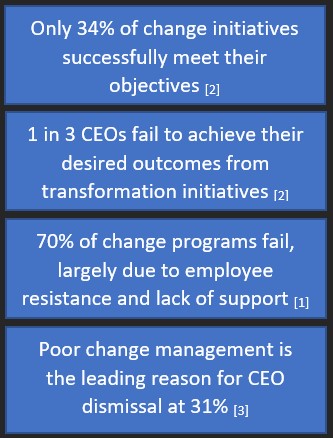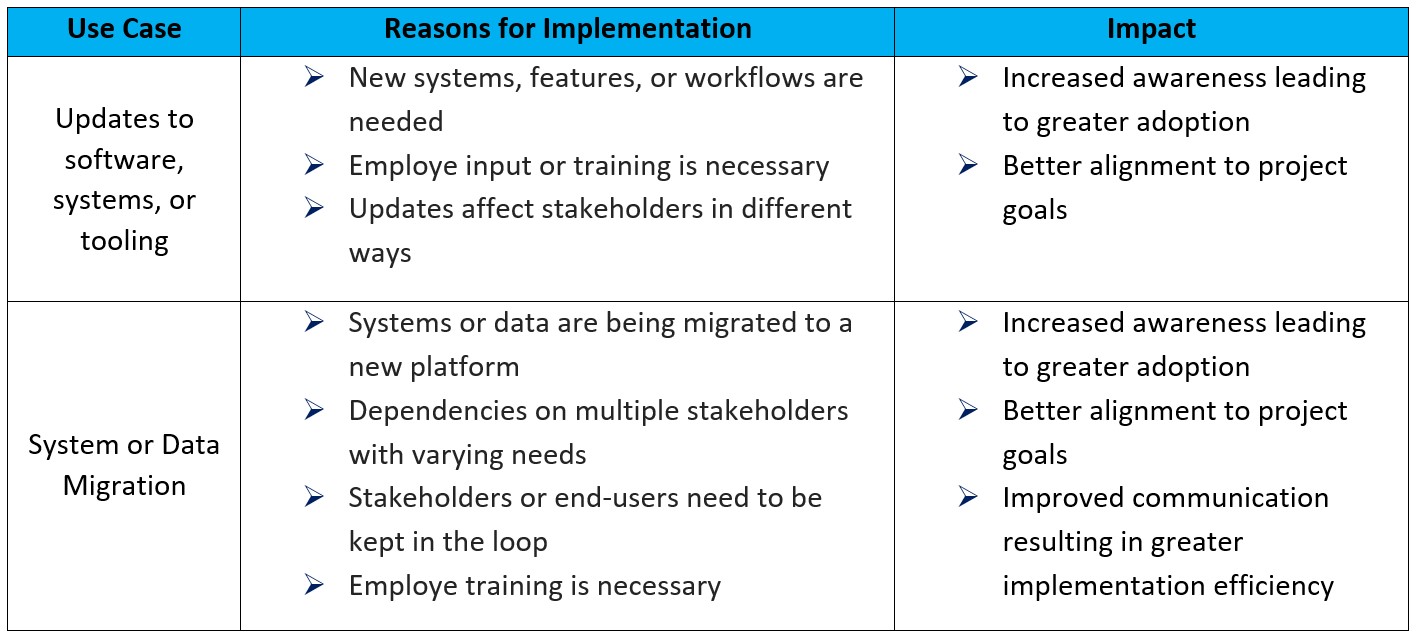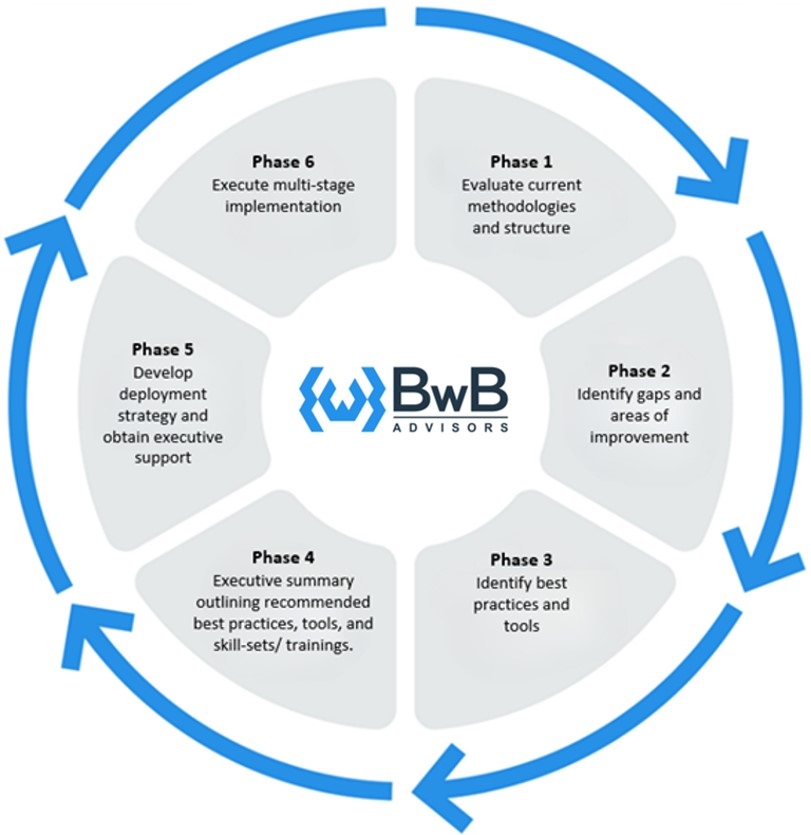Project Management Office - Change Management
Organizations are constantly adapting and evolving. In order to maximize productivity, a strategic approach to implementing and managing changes is needed. In this installment or our project management briefings series, we will focus on Change Management - its key benefits, business impact and use cases.
Overview:
Change management provides a structured approach to transitioning from an organization's current state to a desired future state, focusing on managing the human aspect of changes. This can include changes in processes, technologies, organizational structure, or any other aspect of how work is done. The concept of change management dates back to the early 1900s when academics began studying how humans experience and respond to change; this concept has continuously evolved over the decades to create a comprehensive framework for guiding organizations through transitions. In today’s rapidly evolving markets, having a well-architected change management structure in place is becoming increasingly essential for organizations that want to remain competitive and adaptive .
.
Although change management has been around for a while, many organizations still do not fully leverage it, and as a result, face more issues. According to a 2019 statistic from McKinsey & Company, "70% of change programs fail to achieve their goals, largely due to employee resistance and lack of management support" [1]. Furthermore, 31% of CEOs are fired due to inadequately managing organizational change, making it the leading cause of CEO dismissal [3]. However, a significant portion of these failure-causing issues can be efficiently mitigated by implementing a comprehensive change management structure, helping to ensure the success of projects.
Change management is a broad topic that encompasses many areas; but for the purposes of this article, we will focus on the following key aspects necessary in implementing a successful change management structure: Communication, Training, and Stakeholder management.
Communication and transparent messaging is a vital component of change management that involves building awareness and support for organizational change by delivering information and materials in a timely and consistent manner, ensuring stakeholders understand the reasons behind changes and expected outcomes, and providing ways to share feedback and ask questions. Establishing two-way communication channels fosters collaboration and inclusivity, while consistency in communication across platforms minimizes confusion. Training is another critical aspect of change management as it equips employees with the knowledge and skills required to effectively perform their jobs in the new environment.
Training should be tailored to the specific needs of each stakeholder group and should be delivered in a way that is engaging, interactive, and relevant. Ensuring that employees are adequately prepared to handle the changes and can contribute to the success of the change effort makes transitions smoother and fosters an ongoing learning culture.
Stakeholder Management is the process of building relationships with stakeholders to ensure their support for the change effort. This involves identifying and analyzing diverse stakeholders, actively engaging them, and developing change management plans aligned with their needs. Effective stakeholder management helps identify potential resistance to change and develop strategies to overcome it. For any project to be successful it is essential to ensure that stakeholders are engaged and committed to the change effort.
While there are several other components to change management, these key elements significantly contribute to creating an environment where individuals and teams are well-prepared, informed, and actively engaged in the change process, fostering successful adaptation to new challenges and opportunities.

Key Benefits:
When implementing changes within an organization, having a clearly defined change management structure offers a variety of benefits by providing a standard set of guidelines that ensures the changes are well architected, communicated, and supported both during and after implementation. While the benefits can vary based on how the change structure is defined, some of the most common benefits include:
Reduced Risk: By following a structured change management process, organizations can identify potential risks and challenges early on and take proactive measures to mitigate them, reducing the likelihood of failure and minimizing the impact of any issues that may arise.
Smooth Transitions: Change management helps to ensure that changes are implemented in a structured and organized manner to minimize disruption to the organization’s operations. This helps ensure that employees are not overwhelmed by the changes and can continue to perform their duties effectively. Additionally, clear communication and training initiatives ensure that employees are better prepared to adapt, reducing the likelihood of confusion or resistance.
Improved Alignment with Strategic Goals: By assessing the impact of the changes on different aspects of the organization, such as operations, employees, and customers, a change management structure helps ensure that all changes are aligned with the organization’s strategic goals and objectives. This can help improve performance, increase efficiency, and maximize ROI.
Enhanced Communication: Change management involves clear and effective communication with stakeholders, employees, and other parties involved in the change. This ensures that everyone understands the goals and objectives of the change, and is aware of their roles and responsibilities. Furthermore, change management structures encourage two-way communication, providing channels for feedback to allow employees to express their concerns, ask questions, and feel heard.
Increased Adaptability: By involving employees in the change process and encouraging feedback and suggestions, organizations can become more agile and better equipped to respond to changing market conditions and customer needs.
Use Cases:
While many organizations utilize change management, there are industries and use cases where having a well-defined change structure is crucial. Larger organizations have more departments and teams; therefore there are more dependencies when communicating and implementing changes (more people to train, teams/ systems that rely on one another, etc.), which could increase the risk of failure. Additionally, industries marked by continuous evolution, such as IT, finance, manufacturing, and healthcare recognize the imperativeness of adaptability.
Explore the table below to gain insights into the use cases of change management within the IT industry:

Implementation Best-Practices:
When implementing a change management structure, certain factors should be taken into consideration to maximize its benefits. One of the most important aspects is to start the change management process early; the change management leader (CM leader) should be involved from the very beginning of the project so they are aware of the upcoming changes, can effectively organize and relay information, and can start preparing materials and trainings. Then when the project is kicked-off, the CM leader should immediately begin sharing information, addressing questions, etc. Additionally, a standard communication format should be created at the beginning of each project and be used for all communications so that all information being distributed is organized and easily recognizable.
Another important factor is utilizing the correct tools. The tooling used for change management should be aligned with the standard tooling for the project’s chosen methodology (Waterfall, Agile, etc.). This will encompass items such as documentation, task tracking, progress reporting, etc. Additional non-standard tools (such as video creation software) are also commonly used for creating training material.
Limitations:
While change management is a valuable approach for guiding organizations through transitions, there are some limiting factors. One significant challenge is the inherent resistance to change that some individuals within the organization may exhibit. Despite comprehensive change management efforts, some degree of resistance is inevitable as people tend to feel uneasy about the uncertainty and disruption associated with change. Additionally, some change management structures can often prioritize procedural elements such as communication plans and training modules, without adequately considering the unique needs and concerns of different groups within an organization.
Change management also faces limitations in predictability and resource demands, as unexpected challenges can still arise during the implementation of changes, despite advanced planning. Therefore, organizations may find it challenging to sufficiently allocate time and resources to every aspect of the change process. Being aware of common pitfalls and planning for issues is critical to effectively implementing change management, BwB’s extensive expertise can help guide you through this process and ensure success.
BwB Advisor’s Methodology for Optimizing Project Management:
As the business world continues to evolve, the approach to project management needs to evolve in parallel. Regardless of your organization’s industry, utilizing the correct best practices and management methodologies can help reduce costs and risk, maximize productivity, and improve the quality of deliverables. Nevertheless, organizations should proceed cautiously in deciding what to adopt — one size does not fit all.
At the BwB Advisors our Project Management Optimization Methodology (PMOM) follows a 6 phase process that provides a comprehensive roadmap from identifying key best practices, tools, and methodologies. This helps to ensure a successful implementation that leads to improved productivity, reduced costs, and increased project success.

To learn more about our PMOM, click here or reach out to us to see how our PMOM can help you by clicking here.
December 2023 / Insights / By: Michael T. Casarona
References:
[1] Ewenstein, B., Smith, W., & Sologar, A. (2015, July 1). Changing Change Management. McKinsey & Company. https://www.mckinsey.com/featured-insights/leadership/changing-change-management
[2] Team, W. (2022, October 31). Change management statistics you need to know in 2023. The Change Management Blog. https://change.walkme.com/change-management-statistics/
[3] 31% of CEOs are fired for this reason -. (2023, May 14). https://workweek.com/2023/05/14/31-of-ceos-are-fired-for-this-reason/#:~:text=Do%20not%20ever%20underestimate%20the%20impact%20change%20management,to%20be%20successful%20when%20senior%20managers%20communicate%20continually
.
.
